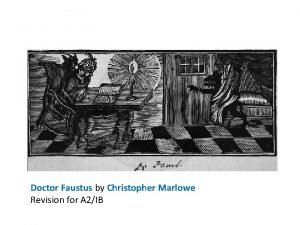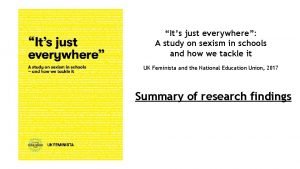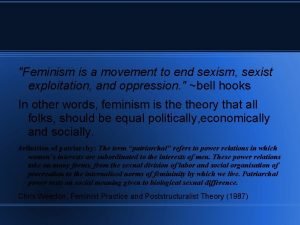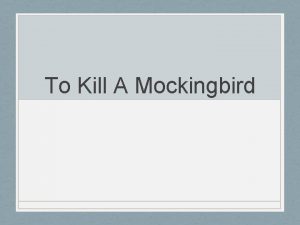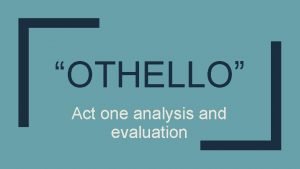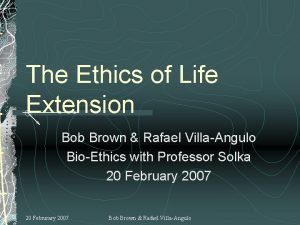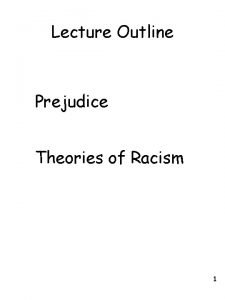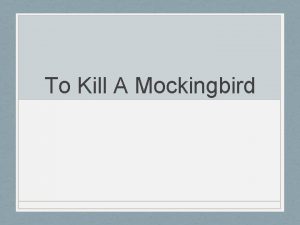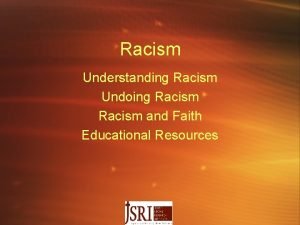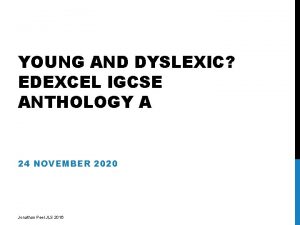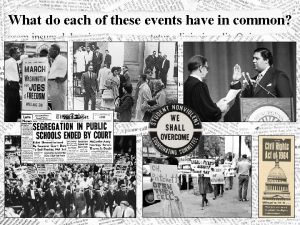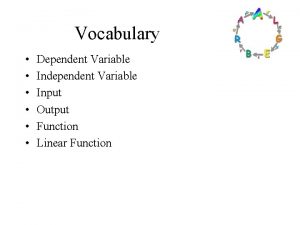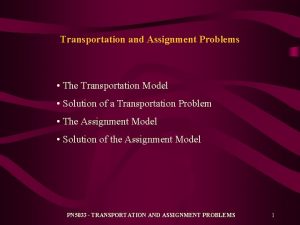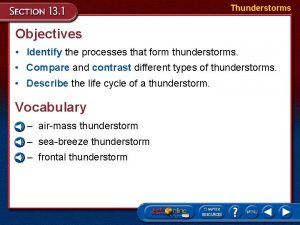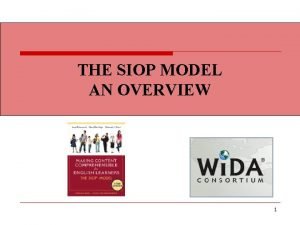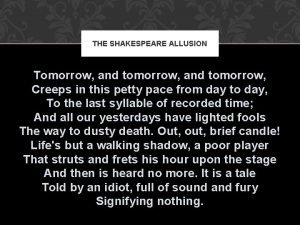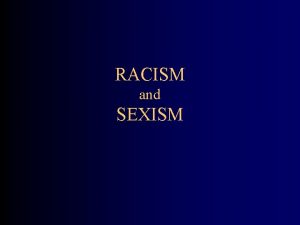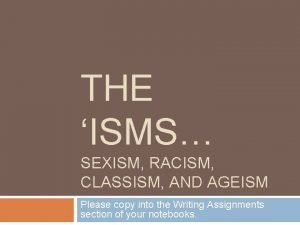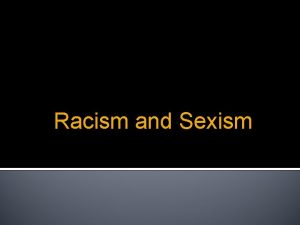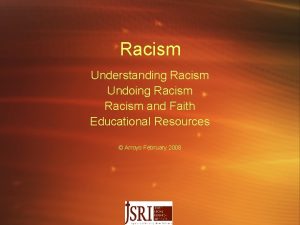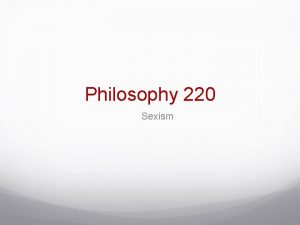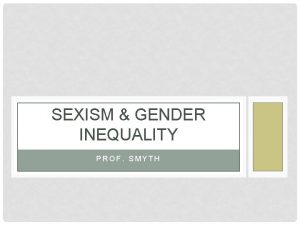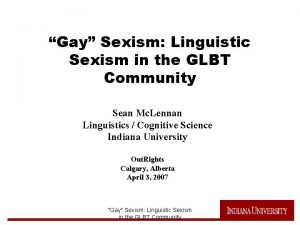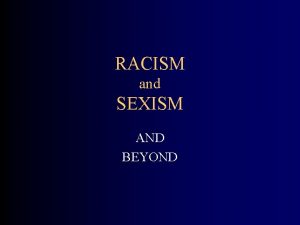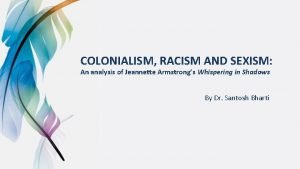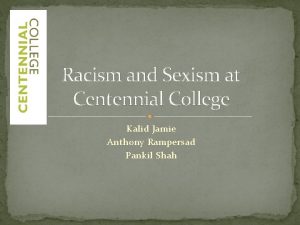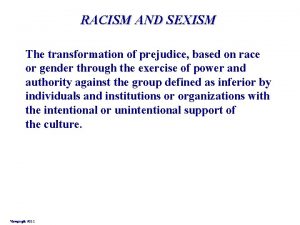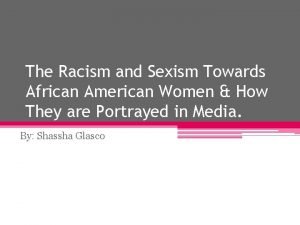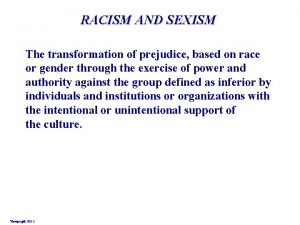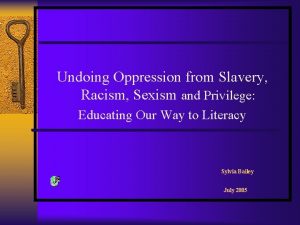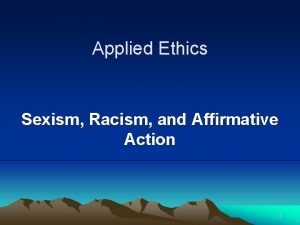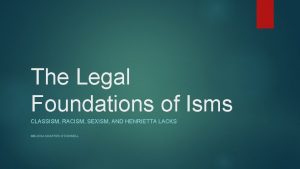Ageism is as odious as racism and sexism



























![Meacham v. KAPL (CA, 2, 2004) [Before Supreme Court ruling in Smith] • KAPL Meacham v. KAPL (CA, 2, 2004) [Before Supreme Court ruling in Smith] • KAPL](https://slidetodoc.com/presentation_image/c0a0e36c643c2d155d260a72aee69fb4/image-28.jpg)

















- Slides: 45

“Ageism is as odious as racism and sexism. ” --- Claude Pepper Background of the ADEA -- 1964 Title VII Debates – Age considered as possible protected class – Congress could not decide if it should be placed under the FLSA or Title VII – Age discrimination was considered a by-product of false beliefs and stereotypes – Congress wanted research on impact of discrimination on older workers and the economy

History of ADEA Secretary of Labor’s findings: – Older workers are disadvantaged in retaining jobs and finding new jobs when displaced – Arbitrary age limits set without consideration of job performance potential can put older workers at a disadvantage – The deterioration of skill, moral, and hire ability due to high rates of unemployment and long-term unemployment is common in older workers and the problem is increasing


Annual growth in labor force by age, projected 2014 -2024 (percent) Source: Bureau of Labor Statistics (click here)

ADEA Amendments Year Overview 1974 Extension of coverage to state, local, and federal entities 1978 EEOC is put in charge of ADEA administration and enforcement, age extension (was enforced by Dept. of Labor previously) 1984 Extension of coverage to overseas subsidiaries 1986 Guaranteed contributions to pension plans for employees that work past 65 in ADEA, ERISA, and IRS Tax Code 1987 Age cap eliminated 1990 OWBPA protections for benefits, early retirement, and voluntary waivers 1991 CRA lengthens time for right to sue • 1967: Age 40– 65 protected • 1984: Age 40– 70 protected

"Opt in" rules – class action Equitable: restore what was lost; Liquidated: the amount of any award for lost or unpaid wages – referred to often as double back pay

~ ADEA Basics ~ Protected Group --- Individuals 40 years old and above • Class is continuous, not categorical – The favored person does not have to be under 40 for the decision to be deemed discrimination – Replacement must be “substantially younger” than plaintiff • Favorable treatment of employees over age 40 compared to those under 40 (and within the protected class) is allowed Covered Entities: Private and public entities with 20 or more employees Kimel v. Board of Regents (2000) Pay discrimination ADEA adverse impact suit. Unlike Title VII individuals have no private right to sue state agencies under the ADEA -11 th Amendment (State sovereign immunity) • 14 th Amendment can revoke 11 th Amendment if: 1) Congruence (past purposeful discrimination) and 2) Proportionality (remedies proportional to unconstitutional conduct. SC: 5 -4 decision; Kimel failed on both • But 11 th amendment does NOT apply to municipalities (e. g. , police, fire depts. ) • EEOC can enforce ADEA against States

~ ADEA Exemptions ~ • Bona fide apprentice programs (e. g. , can refuse to accept those over a given age). Need to be able to show that age at entry is a BFOQ) • Commercial airlines (pilots 65 years old –previously "Age 60 Rule" existed. ( See: The Fair Treatment for Experienced Pilots Act (2007) or “Age 65 Law” • Air traffic controllers (those past 30 can be refused for hire; except retired military air traffic controllers). But, they must retire at age 56

ADEA –Disparate Treatment Burden of Process Phase 1: Challengers must establish a prima facie case by providing evidence of age discrimination by showing that: • They are 40 years old or older • They were qualified for the position in question • They were victims of an unfavorable employment decision (e. g. , not hired, promoted, fired, laid off) • The organization favored an individual who was substantially younger than the challenger OR • Show differential treatment in comparison with similarly situated younger employees (for cases where no obvious replacements, e. g. , RIFs) Phase 2: Company must articulate that a legitimate, nondiscriminatory reason exists for their decision (& age-specific factors of small age differences, same actor defense, RIF, reorganization plans) Phase 3: The challenger proves that the organization's reason for their rejection is a pretext for discrimination

~ Affirmative Defenses in the ADEA ~ 1) BFSS 2) BFOQ (e. g. , public safety) 3) Bona Fide Benefits Plan (BFBP) 3) RFOA (Reasonable Factor Other Than Age) 5) Good Cause (really a subset of RFOA)

BFOQ Defense 1) Proof for a BFOQ: • It is reasonably necessary to the essence of the business • Existence of a reasonable cause (a factual basis) for believing that all or substantially all persons within the protected age group would be unable to perform safely and efficiently the duties of the job(s) involved • It is impossible or impractical to deal with persons in the protected age group on an individual basis • That use of age furthers the stated objective (e. g. , public safety) and no viable alternative exists with equal or less discriminatory effect Adapted from: (Usery v. Tamiami Trail Tours, Inc. (1976); Spurlock v. United

Successful BFOQ Defenses Hiring --- • Starting age of bus drivers 35 years or less (Hodgson v. Greyhound (1974) • Age cutoff for new bus drivers set at 40 years old (Usery v. Tamiami Trail Tours (1976) • Policy of not hiring beginning pilots above 30 years old; EEOC v. American Airlines (1995) Retirement – • Mandatory retirement age for pilots of a private company at age 60 –factual showing was based on FAA rules; Coupe v. Federal Express (1997) • Mandatory retirement for pilot of corporate jets at age 60 –factual showing was based on FAA rules (work performed same as commercial pilots so FAA rules apply); EEOC v. Exxon Mobil (2008)* *"Age 65 Law" went into effect on July 15, 2009

Role of Individual Assessment Western Airlines v. Criswell (1985) Brief facts: --- Western Airlines policy forced flight engineers to retire at age 60; --- Criswell filed an ADEA suit and met his Phase 1 burden under the ADEA Phase 2: Western Airlines claimed that age was a BFOQ • Their primary business was the safe transportation of passengers� • They had a rational basis for believing those over 60 were not qualified • Testing the ability of all flight engineers age 60 or above was impractical

Supreme Court Decision in Criswell ADEA intended a BFOQ to be a relatively narrow exception; a lot of individual variation exists The Court said that the ADEA indicates a: “. . . preference for individual evaluation expressed in the language and legislative history of the ADEA. Under the Act, employers are to evaluate employees … on their merits and not their age. In the BFOQ defense, Congress provided a limited exception to this general principle, but required that employers validate any discrimination as "reasonably necessary to the normal operation of the particular business. " It might well be "rational" to require mandatory retirement at any age less than 70, but that result would not comply with Congress' direction that employers must justify the rationale for the age chosen. ”

Other problems with Western Airline’s position • Other airlines did not require mandatory retirement before age 70 • Western Airlines used individualized tests in other, comparable situations • The Federal Aviation Administration believed that individualized testing was practical for such jobs Criswell won.

Small Age Differences (Substantially Younger Criteria ) O'Conner v. Consolidated Coin Caterers (1996) • O’Conner, 67 years old, was replaced him with someone age 40 (i. e. , someone in the protected age group) • The organization said the O’Conner did not establish a prima facie case because he was replaced by an individual who was also in the protected age group Supreme Court: The ADEA was meant to disallow discrimination because of age. Therefore, the critical evidence for age discrimination in this case was that the person who replaced the fired employee was substantially younger. [Generally, age difference of between 8 -10 years in considered substantial. But, smaller age differences may be sufficient given additional evidence of “The that one person in the protected class has lost out to another person in the age fact animus] protected class is thus irrelevant, so long as he has lost out because of his age. … there can be no greater inference of age discrimination … when a 40 year old is replaced by a 39 year old than when a 56 year old is replaced by a 40 year old. … the fact that a replacement is substantially younger than the plaintiff is a far more reliable indicator of age discrimination than is the fact that the plaintiff was replaced by someone outside the protected class. ”

Mixed-Motive Scenarios • Gross v. FBL Financial Services (2009) – Gross presented indirect evidence that he was demoted for age -based reason -- similarly situated younger workers were treated less harshly – Trial judge ruled FBL could only prevail by proving a legal motive for the demotion, Gross awarded $46, 000 – 8 th Circuit ruled burden of proof could only pass to defense if Gross had direct evidence of illegal motive – Burden of proof should have stayed with plaintiff, jury should have decided if Gross proved age was the determining factor in the decision

Recall? Price Waterhouse v. Hopkins Supreme Court decision • Proper defense standard for proving a legal motive is a “preponderance of evidence” (not “clear and convincing evidence” used by lower courts) • Disagreement on whether an illegal motive (e. g. , sex) must be a motivating factor or a substantial factor (Motivating factor in CRA '91) • O’Conner stated that proof of an illegal must be in the form of direct evidence (used by subsequent lower courts even though she was alone on the Court in this belief) (Indirect or direct allowed in Desert Palace v. Costa) “… What is required is what Ann Hopkins showed here: direct evidence that decision makers placed substantial negative reliance on an illegitimate criterion in reaching their decision. ” Note: Even though O’Conner was alone in requiring direct evidence, the majority of lower courts used this standard in mixed-motive cases

– Supreme Court ruling: The ADEA is NOT governed by Title VII mixed-motive precedents or Price Waterhouse (must use Mc. Donnell-Burdine framework) �Struck down the use of Mixed-Motive Scenarios in ADEA claims From CRA of 1991 Except as otherwise provided in this subchapter, an unlawful employment practice is established when the complaining party demonstrates that race, color, religion, sex, or national origin was a motivating factor for any employment practice, even though other factors also motivated the practice. “Because Title VII is materially different with respect to the relevant burden of persuasion, this Court’s interpretation of the ADEA is not governed by Title VII decisions. . . Unlike Title VII, which has been amended to explicitly authorize discrimination claims where an improper consideration was “a motivating factor” for the adverse action. . . the ADEA does not provide that a plaintiff may establish discrimination by showing that age was simply a motivating factor. ” *** Congress has been unable to alter this ruling despite several attempts

Adverse Impact Scenarios • In the 1980 s courts evaluated ADEA adverse impact following Title VII rules • Geller v. Markham (1980) – 55 -year-old teacher was accepted for an immediate opening and then replaced by a 25 -year-old who was on a lower salary step – Defendant claimed that steps of a salary schedule was job related (preference to those below the 6 th step; cheaper) – Courts rejected this defense due to the correlation between age and steps (those 40 & over were much more likely to be over the 6 th step)

Adverse Impact Scenarios • Leftwich v. Harris-Stowe (1983) – During an RIF: a 47 -year-old tenured professor was released, while a 33 -year-old non-tenured and 62 -year-old tenured professors were retained – Defendant used cost-cutting defense by equating age with higher costs to the employer (also average of retained and released faculty were the same -- CT v Teal bottom line denied) Why not use RFOA defense here? – Courts ruled for plaintiff due to the correlation between tenure and age Summary: – Such decisions were changed with Hazen • In 1980 s, adverse impact claims under ADEA used Title VII rules (3 Circuit courts) • Cost cutting not job-related defense (2 courts) and not usable as RFOA (1 court) • EEOC Guidelines rejected RFOA in ADEA adverse impact cases (required jobrelatedness defense like Title VII phase 2)

Adverse Impact Scenarios • Hazen v. Biggens (1993) – Biggens fired at age 62 after 9 years on the job (10 years needed to be vested in the company’s retirement plan; timing was a few weeks before he was eligible) – Unanimous Supreme Court ruled that decision may be motivated by RFOA even if the motivating factor is correlated with age On average, an older employee has had more years in the work force than a younger employee …. . Yet an employee's age is analytically distinct from his years of service. An employee who is younger than 40 may have worked for a particular employer his entire career, while an older worker may have been newly hired. Because age and years of service are analytically distinct, an employers can take account of one while ignoring the other, and thus it is incorrect to say that a decision based on years of service is necessarily “age based. ” – The Hazen Court never ruled on adverse impact, but noted that disparate treatment captures the essence of what Congress sought to prohibit in the ADEA, implying that adverse impact does not. Plurality thought that it was WRONG to use Title VII adverse impact analysis to the ADEA. The ruling caused many Circuit courts to begin rejecting ADEA adverse impact claims

Biggins was able to show ERISA violation --- e. g. , fired soon before being vested (10 years) Section 510 of the ERISA partly states: It shall be unlawful for any person to discharge, fine, suspend, expel, discipline, or discriminate against a participant or beneficiary for exercising any right to which he is entitled under the provisions of an employee benefit plan, [or ERISA]. . . or for the purpose of interfering with the attainment of any right to which such participant may become entitled under the plan, [or ERISA] Intended to prevent unscrupulous employers from discharging or harassing their ERISA Framework (Burden Shifting Process): employees in order to keep them from obtaining vested pension rights. Prima Facie -- Plaintiff must show (with direct or indirect evidence) that he/she was: 1) covered under an employer’s plan; 2) subjected to adverse employment action; 3) meeting the employer’s reasonable expectations; and 4) discharged under circumstances giving rise to some basis for believing prohibited intent existed (Need to show that employer’s denial of benefits was a motivating factor) • Articulation of legitimate, non-discriminatory reason for adverse action • Proof of pretext

Summary of AI Cases Prior to Smith v. City of Jackson • In 1980 s courts treated adverse impact in ADEA with Title VII rules (e. g. , Geller v. Markham, 1980 & Leftwitch v. Harris-Stowe, 1983) • In Hazen v. Biggens (1993), the Court ruled --- employer decisions may be motivated by "factors other than age. . . even if the motivating factor is correlated with age. " • 3 Justices also stated that there are good reasons to preclude adverse impact claims in the ADEA • After Hazen, most circuit courts rule that adverse impact is unavailable in ADEA as a matter of law, but some courts rule otherwise

Brief Facts in Smith v. City of Jackson • Police officers and dispatchers with less than 5 years experience get higher percentage increases • Those over 40 sue on grounds of adverse impact via ADEA (significant difference of 4 SDs in average of 2 groups) • Lower courts ruled adverse impact is unavailable in ADEA as a matter of law • Supreme Court takes case to settle split among circuit courts

Smith v. City of Jackson (2005) • Adverse impact IS available in the ADEA • City used a RFOA in Step 2 of the burden shifting process (higher salaries given to those with less tenure to compete with surrounding jurisdictions) --- viewed as legitimate even though job tenure was highly correlated with age. • Scalia wanted to use Title VII (business necessity)! He rejected this in Wards Cove (used production) • Stevens used Wards Cove to justify RFOA defense! He dissented in Wards Cove. His logic -- CRA ‘ 91 rejected Wards Cove for Title VII -- NOT the ADEA. • Referring to Wards Cove to justify RFOA caused major confusion since this implied a “production” defense in Phase 2

![Meacham v KAPL CA 2 2004 Before Supreme Court ruling in Smith KAPL Meacham v. KAPL (CA, 2, 2004) [Before Supreme Court ruling in Smith] • KAPL](https://slidetodoc.com/presentation_image/c0a0e36c643c2d155d260a72aee69fb4/image-28.jpg)
Meacham v. KAPL (CA, 2, 2004) [Before Supreme Court ruling in Smith] • KAPL instituted an RIF for employees with 20 or more years of experience • Over 98% of RIF victims are 40 or older (30/31 laid off) • KAPL articulates non-discriminatory reason(s) for its decisions (criticality of skills and flexibility for retraining) Step 2 under Wards Cove • Plaintiffs proved there alternatives with less adverse impact, including (a) hiring freeze and (b) extension of a voluntary separation plan to employees with less than 20 years of service • Plaintiffs Win

Meacham v. KAPL (CA, 2 2006) After Supreme Court ruling in Smith [SC agreed to Meacham case but sent it back to 2 nd Circuit after its Smith decision) • 2 Circuit judges agree that KAPL’s articulation was sufficient to satisfy an RFOA • Plaintiffs required to prove the articulation was unreasonable -which they could not do >>> Plaintiffs lose 2 -1 • 3 rd judge writes long dissent (e. g. , RFOA is an affirmative defense and thus requires persuasion/proof)

Supreme Court Ruling in Meacham v. KAPL • Supreme Court unanimously agrees with the dissenting judge, listing numerous reasons why statutory defenses such as RFOA are affirmative defenses The ADEA’s text and structure indicate that the RFOA exemption creates an affirmative defense, for which the burden of persuasion falls on the employer. The RFOA exemption is listed alongside one for bona fide occupational qualifications (BFOQ), which the Court has recognized to be an affirmative defense. . . this Court has spoken of both the BFOQ and RFOA as being among the ADEA’s “five affirmative defenses. ” • Court rules 7– 1 for Meacham that the employer must meet the burden of persuasion (i. e. , prove their RFOA, not simply articulate it)

~ Moral of Smith and Meacham ~ • Very hard for plaintiffs to win with factors that are correlated with age (as in Smith) • However, decisions that negatively affect actual employees (as in a RIF) can be problematic for employers (e. g. , Meacham) Recommendation: In a RIF, avoid criteria such as “flexibility” and “criticality” unless you can affirmatively prove they are reasonable

~ Same Actor Defense ~ “When the same person was responsible for hiring and terminating an individual, who was already a member of the ADEA protected class when hired, there is an inference that age was not the reason for the termination. ” (From White v. Omega Protein, 2003) – Introduced by Proud v. Stone (1991) • Proud was both hired and fired by Klauss -- terminated 6 months later for poor performance • Klauss documented performance problems and attempted to help Proud improve performance as a supervisor • No evidence inference of discriminatory animus based on age But, supplemental evidence can counter same-actor defense –Madel v. FCI Marketing (1997) • Carlson had hired and recommended termination for both Madel and Brennen • Substantial evidence of age-based derogatory remarks by Carlson Plaintiffs have created a fact issue as to whether FCI’s proffered reasons are pretextual, and Carlson’s age-based epithets create a reasonable inference that age was a determinative factor in the termination decision. [emphasis by authors]

Karlo v. Pittsburg Glass Works (2017) Reduction in Force (Layoffs) Subgroup Comparisons allowed under ADEA? Age Range 40 No evidence of adverse impact 49 50 Alleged adverse impact 3 rd Circuit allowed use of age categories above 40 years old – otherwise masking effect possible O’Conner decision (substantially younger) and Teal decision (“bottom line” defense NOT allowed) as rationale

After-Acquired Evidence • Evidence acquired by defendant AFTER challenged employment decision • Summers v. State Farm (1988) – Ruled in for defendant due to fraudulent findings of plaintiff (falsifying records after he was terminated) Later Cases (Defense victories) • Washington v. Lake County (1992): failure to reveal felony conviction on application • Johnson v. Honeywell Information Systems (1992): resume fraud • Welch v. Liberty Machine Works (1994): failure to reveal a prior termination for poor performance) • O’Driscoll v. Hercules (1994): lying about age on job application Plaintiff victories -- remedies for use of illegal motive) • Wallace v. Dunn Construction (1992): failure to reveal felony drug charge on application) • Kristufek v. Hussman Foodservice (1993): falsified application • Mardell v. Harleysville Life Ins. (1994): resume fraud

After-Acquired Evidence Supreme Court Decision --Mc. Kennon v. Nashville Banner (1995) • Supreme Court ruled defense did not know of illegal actions until after termination; could not have been motivated by knowledge it did not have • Underscores importance of determining motive on part of employer "The employer could not have been motivated by knowledge it did not have and it cannot now claim that the employee was fired for the nondiscriminatory reason. " • Overall, in after-acquired cases, remedies (e. g. , back pay) are permitted up until the point of discovery of a prior illegal/fraudulent act but allow no remedies beyond this point After-acquired evidence reduces to mixed motive after the fact: • Alleged illegal motive (e. g. , discriminatory termination) is current but • Alleged legal motive (e. g. , a prior fraudulent act) was in the past

The BFBP (Bona Fide Benefits Plan) Defense • Originally legal to discriminate in benefits based on age if a plan was “not a subterfuge (a scheme) to evade the purposes of the ADEA” • The DOL and EEOC defined subterfuge as any differential treatment of older versus younger workers in benefits (unless the benefits were more costly for older workers) Not law --- struck down for a time in subsequent cases (e. g. , Mc. Mann, Betts)

The BFBP Defense • United Airlines v. Mc. Mann (1977) – Mc. Mann voluntarily signed up for a retirement plan in 1964 and retired in 1973 at age 60 – ADEA enacted to protect older workers in 1967 Mc. Mann challenged the plan as a subterfuge/scheme to avoid ADEA – Any plan that predated ADEA could NOT be considered as a subterfuge/scheme • Congress amended ADEA in 1978 and deemed ANY PLAN forcing retirement below the protected age limit (unlimited now) to be a subterfuge regardless of implementation date (see top of page 295)

The BFBP Defense • Retirement System of Ohio v. Betts (1989) – Betts was over 60 and disabled – Forced to choose between unpaid medical leave and retirement benefits paying $158. 50/month – If she was under 60 she would have received disability benefits paying $355/month Plans not based on cost differences base on age (ok by the EEOC) – 6 th circuit rules for Betts – Supreme Court: Congress' 1978 amendment did not remove subterfuge – just redefined it forced retirement. Based on Mc. Mann (voluntary retirement), needed to prove subterfuge. EEOC position of actuarial costs not included '78 amendment (top pg. 295) – So, plaintiff needed to show that Ohio used a scheme to intentionally discriminate against older people ---- Betts lost.

The BFBP Defense • Congress reversed Betts in Title 1 of the OWBPA by: - Eliminating the term subterfuge/scheme as it pertains to benefits in ADEA language (not required) • Benefits based on age illegal unless: – Benefits are more costly for older workers (codified EEOC regulations) – Plan is part of a legitimate voluntary early retirement package that is consistent with ADEA (overruled Betts)

The BFBP Defense • Kentucky Retirement System v. EEOC (2008) [Better benefits for disabled younger employees] – Workers under 55 who were disabled: given retirement benefits (years added to pension) – Workers over 55 who became disabled not given similar benefits • Defendant claimed retirement package was based on years of services, age, and eligibility for retirement (e. g. , their decision was not motivated by age as in Hazen v. Biggens) • Courts agreed that a plan based on factors correlated with age (using Hazen v. Biggens case) is exempt from OWBPA coverage – As a result, the burden is on the plaintiff to show pretext >>> Minority (using Congress’ objection to Ohio v. Betts thought defendants have the burden of proof to show increased costs basis for plan >>> Odd decision and odd combo of judges; stay tuned for how this case will be interpreted by courts and Congress’ role

Older Worker Benefits Protection Act of 1990 (OWBPA) • Addresses four issues: – – Bona Fide Benefits Plan (BFBP) statutory defense Early retirement packages Voluntary early retirement Voluntary waivers of ADEA rights • Title I—addresses the Bona Fide Benefits Plan (BFBP) • Title II—addresses voluntary waivers of ADEA rights

Voluntary Early Retirement (Basics) • OWBPA makes early retirement packages legal as long as they are not coercive and inconsistent with the purposes of ADEA • Plans that do NOT have maximum ages are legal • It is legal for packages to be enhanced where older workers receive more benefits than younger workers even within the protected group • The legal packages are often based on a combination of years of service (seniority) and starting age

~ OWBPA ~ Voluntary Waiver Rules Rule 1 It is clearly written and easily understood by the average individual Rule 2 It refers to rights or claims that fall under ADEA Rule 3 Does not include claims that may arise after the waiver is signed Rule 4 Benefits must offer something new; not something of value to which the individual is already entitled Rule 5 Employees are advised in writing of their right to seek counsel Rule 6 It provides 21 days for individuals (45 days for groups) to make a decision Rule 7 It is revocable within 7 days of signing Rule 8 For group offers, employees must receive extensive additional information about all employees

• Carras v. MGS (2008) – 62 -year-old was terminated and a younger worker was hired – Cost-cutting factors were cited as the reason for termination – However, Carras had offered to take a pay cut in order to keep his job – The new hire was being paid more than Carras had offered to work for – Carras showed pretext and the courts ruled in his favor

Some Compliance Issues – Do not include any age limitations or wording that deters older workers from applying in advertisements – Do not ask questions that elicit age-related information on applications (such as graduation dates) – Although cost cutting is a viable RFOA (as an affirmative defense), if it is used as a pretext then it is illegal: Carras v. MGS (2008) – Discourage age-based remarks, even those made in jest; avoid hostile, derogatory remarks – Be cognizant of age differences in replacements
 Now faustus must thou needs be damned
Now faustus must thou needs be damned Romeo and juliet balcony scene script
Romeo and juliet balcony scene script Lion king sexism
Lion king sexism It's just everywhere sexism in schools
It's just everywhere sexism in schools Sexism is interwoven with patriarchy
Sexism is interwoven with patriarchy Sexism in sexist photo
Sexism in sexist photo Shakespeare's tragedy about racism and jealousy
Shakespeare's tragedy about racism and jealousy Examples of jealousy in literature
Examples of jealousy in literature Racism and slavery
Racism and slavery Neil farrington
Neil farrington To kill a mockingbird page count
To kill a mockingbird page count What did mr underwood's editorial say
What did mr underwood's editorial say I follow him to serve my turn upon him technique
I follow him to serve my turn upon him technique Thematic statements
Thematic statements Cry the beloved country themes and quotes
Cry the beloved country themes and quotes Documented essay outline
Documented essay outline Racism thematic statement
Racism thematic statement What do about racism
What do about racism Racism scale
Racism scale Individuality theme statement
Individuality theme statement Who put the blanket around scout's shoulders
Who put the blanket around scout's shoulders Understanding racism
Understanding racism Heart of darkness slavery quotes
Heart of darkness slavery quotes Heart of darkness part 2
Heart of darkness part 2 A dreaming black boy poem
A dreaming black boy poem White and gray
White and gray And because i am happy and dance and sing
And because i am happy and dance and sing Compare and contrast west side story and romeo and juliet
Compare and contrast west side story and romeo and juliet Taller and younger older and shorter
Taller and younger older and shorter How to write 5 centavos
How to write 5 centavos Red orange yellow green blue purple violet
Red orange yellow green blue purple violet One night a theater sold 548 movie tickets
One night a theater sold 548 movie tickets Young and dyslexic analysis
Young and dyslexic analysis What did the sibley commission do
What did the sibley commission do West yorkshire health and care partnership
West yorkshire health and care partnership Compression and rarefaction
Compression and rarefaction Compare and contrast spring and neap tides.
Compare and contrast spring and neap tides. Independent variable x or y
Independent variable x or y Lesson 5 verbs action (transitive/intransitive) answer key
Lesson 5 verbs action (transitive/intransitive) answer key What are your life roles
What are your life roles Maintenance of patient records and reports
Maintenance of patient records and reports Prohibited route in transportation problem means
Prohibited route in transportation problem means Compare and contrast cold wave and wind chill factor
Compare and contrast cold wave and wind chill factor Purchases in profit and loss account
Purchases in profit and loss account Lesson preparation siop
Lesson preparation siop William shakespeare tomorrow and tomorrow and tomorrow
William shakespeare tomorrow and tomorrow and tomorrow
